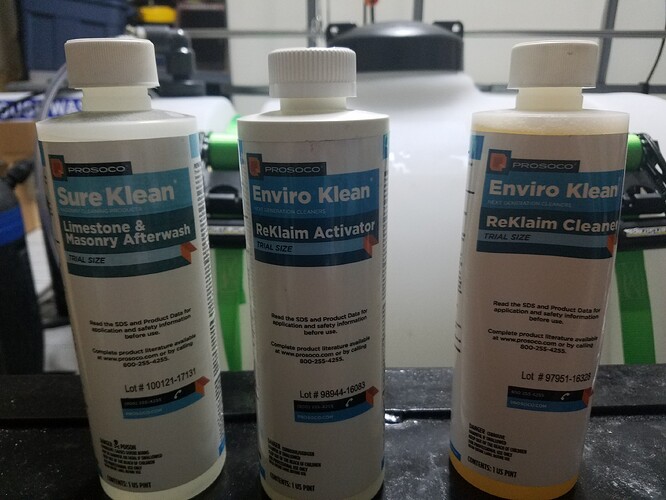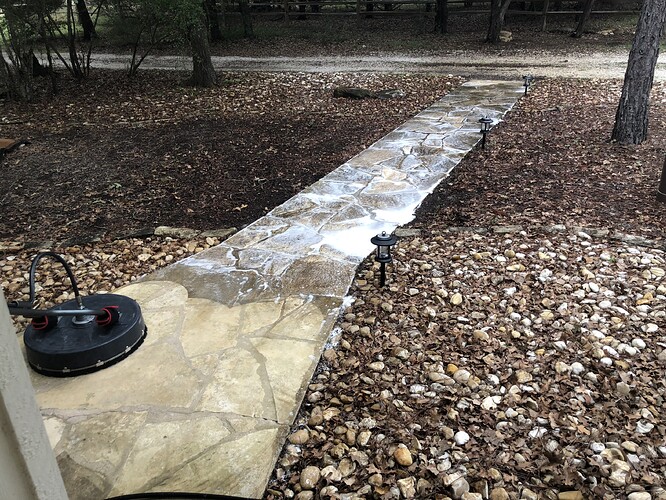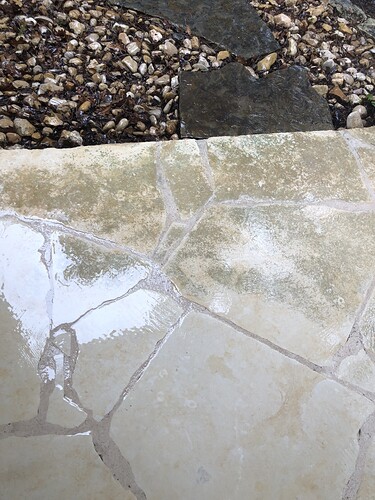got a call today from a customer about cleaning a limestone patio with tons of black spots (i would assume some type of algae) i know limestone is extremely delicate so wanted to run my process by you exprienced limestone guys. Planned on doing a 50/50 hw mix, directly apply and soft brush, followed by a soft heated surface cleaning. Any input on a better process?
Watching
You’ll need to neutralize the SH. Citric acid or acetic acid.
Also, does it have a finish applied to it?
Got pics? You probably don’t need a 50-50 mix.
job is scheduled for tomorrow afternoon! deciding if this should be down streamed or applied straight with a soft brush either 50/50 or 40/60
You most likely wont be able to down stream. Will need to be applied straights at either ratio you mentioned. Sometimes more than one coat.
Soft rinse or surface clean? I know this stuff is soft
Soft-ish rinse, i dont use a surface cleaner on limestone. The mix takes care of most of the work, rinsing is mainly to flush the sh of the surface. Be careful of too much mix on the surface though if there is nice grass near by. 50/50 is a hot mix and when you rinse, it get pushed right into the grass.
2% probably plenty strong. So have you done it yet?
just finished it guys and it cleaned up great! soft brushed the heavy areas and used a heated soft rinse
Happen to have any Before & Afters? I just finished a job today and am not thrilled of the results. The mold and algae came up but not this other lite green. Does it even come off?
did the hot water make all the difference? I xJet for bout 3% on surface and nil. It wouldn’t lighten up.That is mold in the pores of the stone. I deal with this all the time. It is repeat applications and increasing strength of SH to get it gone. Neutralize between washes and minimize reaction to iron in stones that brings out the orange. Limestone is all over the place here and weak mixes do nothing but take the surface junk off. Been trying Prosoco Reklaim with limited results. Not sure if heat does a lot either. I keep trying it, and it does not seem to do much better than cold. Again, the mold gets deep down into the pores. Just yesterday, I had to use a gal 12.5% SH with .5 gal water mix to finally get the mold killed. So that is around 9% hitting the surface…
Are you neutralizing with oxalic acid?
Either OA or Citric Acid.
If it has been “honed” which is when the surface is sanded down to almost a smooth finish (it looks smooth, but when you rub your hand against the stone if feels like medium sand paper still), it gets really fun. I had a building this weekend that had honed limestone bricks that topped the building and walls. After a lot of trial and error, I found that spraying with 50/50 SH/Water mix and just letting it soak in (basically dry) was the only way to get rid of it. I did a test spot first, and after 4 applications of doing just that if finally went away and luckily no orange came out with the stone staying its original white-ish/gray. Go figure…
You can also try a poultice which works in some situations, just a bit time consuming. I found on limestone a high % concentration (20%) hydrogen peroxide and diatomaceous earth seems to work the best. Basically, you mix the two into a peanut butter mud, apply to and around the stain and then cover with saran wrap snugly. Let dry 24 hours and then come back using a plastic scrapper gently peel off the dried mud. The idea is that it sits on the stain and penetrates into the pores of the stain while the saran wrap slows down the drying process for this to happen. As it dries, it pulls out the mold from the pores into the mud. It does work in some instances, but keep in mind it takes 24 hours for each application and depending on the stain may take 2-3 applications to fully remove the stain. If after 1 application there is no difference in the stain, then this process will not work at all. If you see a difference in the stain (if not totally gone) then keep doing applications. Just FYI - I nomrally would only do this with high $ stone work (historical, statues, etc) where risking SH or other processes carry too great a risk.




